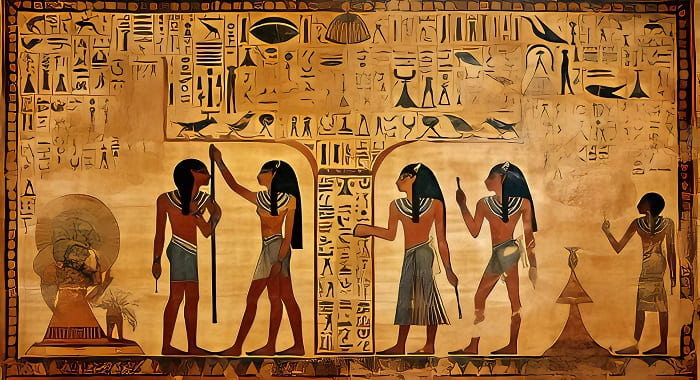
Encryption in Ancient Egypt: Step into the shadows of history and embark on a journey where the sands of time conceal more than just ancient relics. Beyond the towering pyramids and enigmatic pharaohs lies a realm of mystery encoded in the very fabric of ancient Egyptian civilization.
In the hallowed halls of temples and the sacred inscriptions of tombs, the Egyptians mastered an art that transcended time – the art of encryption. Encryption in ancient Egypt was not only the cornerstone of cryptography for many civilizations, including the Jews, Greeks, and ancient Romans, but it also influenced other societies. The Iranians and Indians, among others, drew inspiration from Egyptian encryption methods. Even in later periods, such as the medieval era and modern times, methods like Enigma and Vigenère may have borrowed from ancient cryptographic techniques, including those of the ancient Egyptians.
Therefore, understanding the coding of ancient civilizations, including Egypt, Persia, China, India, and Japan, can be a way to step into the new world. This article beckons you to unravel the layers of secrecy that enshrouded the banks of the Nile, exploring the fascination with ancient Egypt, delving into the cryptic world of encryption in ancient civilizations, and uncovering the profound significance of encrypting secrets to preserve the delicate balance of power and knowledge. Join us on a mesmerizing odyssey as we decode the cultural tapestry that binds the allure of ancient Egypt to the enigmatic dance of symbols and secrets woven into its very existence.”
Table of Contents
The History of Egypt at a Glance
The ancient Egyptian civilization, flourishing along the banks of the Nile River for thousands of years, remains one of the most iconic and influential cultures in history. Its longevity, spanning from the Early Dynastic Period (c. 3100–2686 BCE) to the Ptolemaic Kingdom (332–30 BCE), witnessed the rise and fall of pharaohs, the construction of monumental structures, and the development of a rich and complex societal structure.
The Nile, with its annual flooding, bestowed fertile soil upon the land, enabling the Egyptians to thrive agriculturally. This stability allowed them to build grand cities like Memphis and Thebes, where monumental structures like the pyramids and temples attested to their architectural prowess.
B. Achievements in Science, Mathematics, and Hieroglyphics
Ancient Egypt was a cradle of intellectual achievement, making significant contributions to various fields. In science and medicine, they demonstrated advanced knowledge, as evidenced by their understanding of anatomy, medical treatments, and astronomical observations.
In mathematics, the Egyptians developed a sophisticated system, particularly in geometry, essential for tasks such as land surveying and the construction of architectural marvels. The use of fractions and mathematical knowledge embedded in their architectural designs showcased their advanced numerical understanding.
Hieroglyphics, the intricate writing system of ancient Egypt, was not merely a utilitarian tool but a form of art and expression. The Rosetta Stone, with its trilingual inscription, became a key to unlocking the mysteries of hieroglyphics, revealing a wealth of literary, religious, and administrative texts.
C. Importance of Secrecy in Religious Rites, Government, and Military Affairs
Secrecy held a paramount role in various aspects of ancient Egyptian society, reflecting a profound connection between the spiritual, governmental, and military spheres.
In religious rites, the encryption methods employed by Egyptian monks, such as Disordered Hieroglyphics, showcased a commitment to keeping sacred knowledge within the confines of their inner circle. The very essence of religious mystery and ritual demanded a level of privacy that encryption provided.
Within the government, the need for confidentiality in administrative and diplomatic correspondences was evident. Encryption methods like the scytale and the Caesar Cipher served as tools to protect sensitive information, ensuring that messages between officials and pharaohs remained secure.
The military, a cornerstone of ancient Egyptian power, relied on encrypted communications to safeguard strategic plans and troop movements. The application of cryptography, especially in methods like the Caesar Cipher, demonstrated an understanding of the tactical advantages provided by secure communication.
In summary, the historical context of ancient Egypt unveils a civilization marked by extraordinary achievements in various domains. From the grandeur of architectural marvels to the intricacies of hieroglyphic writing and the strategic application of encryption in secrecy, ancient Egypt’s legacy resonates as a beacon of human ingenuity and the enduring quest for knowledge.
Explanation of Hieroglyphics as the Written Language for Encryption in Ancient Egypt

Embark on an intricate exploration of the cryptic world of ancient civilizations, where the Egyptian hieroglyphics transcend the conventional role of communication to become a multifaceted tool, including a fascinating application as a form of encryption. In this comprehensive journey, we delve deep into the captivating facets of Hieroglyphics as Code in Ancient Egypt.
The roots of hieroglyphics extend over 5000 years into pre-dynastic Egypt, evolving across the Old Kingdom, Middle Kingdom, and New Kingdom. Beyond its conventional use, hieroglyphics concealed secrets through intricate symbols, laying the foundation for a unique form of encryption. The system’s complexity allowed ancient Egyptians to encode messages, ranging from religious rituals to the protection of valuable information.
Monumental Inscriptions:
Hieroglyphics, the most ornate script, found its pinnacle in monumental inscriptions, notably in temples and tombs. These inscriptions served as more than artistic expressions—they became a canvas for encryption. An exemplary artifact is a granite stela dating back to the Middle Kingdom, approximately 4000 years ago. This stela not only showcased artistic prowess but also highlighted the potential for encryption. The symmetrical arrangement of hieroglyphs allowed them to be read in two directions, demonstrating the script’s complexity and its ability to conceal messages within the artistry.
Hieratic Script:
Recognizing the laborious nature of carving or painting hieroglyphics, the ancient Egyptians developed the hieratic script. This more cursive and simplified form of writing provided a practical solution for everyday documents. Hieratic script became an ideal candidate for encryption on letters, contracts, and other mundane records, showcasing the adaptability of hieroglyphics as a coded language. Hieratic script preserved the essence of hieroglyphics but facilitated a more streamlined writing process.
Demotic Script and Beyond:
Around the seventh century BCE, a later phase of script known as “demotic” emerged, evolving from the hieratic script but closer to the spoken language of the time. Initially used for less formal documents, demotic script later expanded its usage to encompass religious texts and works of literature. Four exquisite wooden pages from ancient Egypt showcase this evolved script, meticulously recording planetary observations for a 62-year period. This demonstrates the script’s use in preserving scientific knowledge and its capacity to evolve with the changing linguistic landscape.
Hieroglyphics as Code in Ancient Egypt intertwines art, religion, and secrecy. With roots extending over millennia, hieroglyphics evolved into a sophisticated writing system, simultaneously concealing and conveying messages. The Rosetta Stone, monumental inscriptions, hieratic, and demotic scripts stand as testament to the adaptability and enduring legacy of hieroglyphics as a coded language. Decoding these ancient scripts unravels the stories of the past and uncovers hidden messages that continue to captivate our imagination today, shedding light on the ancient Egyptians’ ingenious use of hieroglyphics as a dynamic tool of expression and encryption.
Examples of Encrypted Messages in Ancient Inscriptions and Texts
While ancient civilizations, including the Egyptians, did not employ encryption in the modern sense, they developed various methods to conceal information within their inscriptions and texts. Here are examples of practices that can be considered akin to encrypted messages in ancient times:
- Hieroglyphic Symbolism: Hieroglyphic symbolism in ancient Egypt transcended mere writing—it was a profound art form conveying layers of meaning. Each symbol, like the iconic ankh, held multifaceted interpretations, from life to the sacred and eternal. Cultural context was paramount; a symbol’s significance evolved based on its surroundings and Egyptian societal nuances. Ritualistic and religious, hieroglyphic symbols were chosen for their sacred connotations, woven into religious texts and temple inscriptions. More than words, hieroglyphs formed visual narratives, telling captivating stories of history and mythology. Today, decoding these symbols reveals not just linguistic meanings but offers profound insights into the wisdom, beliefs, and artistry of ancient Egypt. Hieroglyphic symbolism was a cultural code, a visual key to understanding the rich tapestry of Egyptian civilization.
- Boustrophedon Writing: Boustrophedon writing, a distinctive ancient script style, meandered like a plow turning back and forth in fields. In this method, each line of text alternated its direction—first right-to-left, then left-to-right. The term “boustrophedon” itself means “ox-turning” in Greek, reflecting the pattern’s resemblance to an ox’s movement in plowing. This unique approach added a layer of complexity to deciphering inscriptions, as readers needed to navigate the changing flow of text. The deliberate alternation wasn’t merely aesthetic; it demanded a nuanced understanding of script patterns, making it an ingenious yet intricate form of written communication in the ancient world. Unraveling boustrophedon writing unveils the deliberate choreography embedded in the language’s visual presentation.
- Sculptural Encryption: Sculptural encryption in ancient Egypt elevated hieroglyphics beyond mere inscriptions, transforming them into artistic puzzles. The method involved crafting symmetrical arrangements within sculptures or stelae, concealing cryptic messages within the visual allure. These arrangements were more than aesthetically pleasing—they served as encoded narratives waiting to be deciphered. The deliberate placement of hieroglyphs allowed messages to emerge only when the viewer engaged with the artwork in specific directions. Sculptural encryption exemplified a fusion of art and secrecy, ensuring that the stories within the hieroglyphs were not only preserved for eternity but also veiled in an artistic enigma, awaiting the inquisitive minds of historians and archaeologists to decode the encrypted tales of ancient Egypt.
- Rebus Principle: The Rebus Principle in ancient Egyptian hieroglyphics was akin to a linguistic puzzle manifested visually. It involved the clever use of symbols to represent not only specific objects or sounds but also abstract ideas and words. This phonetic play allowed for a multi-layered interpretation of a single symbol, relying on the viewer’s familiarity with the cultural and phonetic nuances. For instance, an image of an “eye” could signify the pronoun “I” or the affirmative word “aye.” The Rebus Principle added a dynamic, wordplay dimension to hieroglyphics, turning them into a visual cipher where the intended meaning often transcended the literal, demanding a nuanced understanding of language and cultural references for accurate interpretation.
- Homophonic Substitution:In the realm of ancient writing, the Homophonic Substitution technique introduced a layer of ambiguity by employing interchangeable characters with similar sounds. This method allowed ancient cultures, including the Egyptians, to play with phonetics in their inscriptions. Characters that shared auditory similarities could be used interchangeably, creating a subtle challenge for those unfamiliar with the specific sound-related substitutions. The result was a cryptic text that required not only linguistic knowledge but also an awareness of the nuanced auditory landscape of the language. Homophonic Substitution, through its clever manipulation of sounds, added a sonorous complexity to ancient scripts, turning deciphering into a puzzle of auditory recognition and linguistic cleverness.
- Polyalphabetic Substitution: In the intricate tapestry of ancient scripts, Polyalphabetic Substitution stood as a sophisticated method to enhance secrecy and complexity. Unlike common writing practices, this technique involved incorporating multiple scripts or alphabets within a single text. Each script acted as a cipher, introducing an added layer of confusion for the uninitiated reader. Historical instances of Polyalphabetic Substitution demonstrated a strategic play with different writing systems, compelling those decoding the message to navigate through shifting linguistic landscapes. While not a prevalent practice, this cryptic approach showcased the ingenuity of ancient civilizations, utilizing diverse scripts to weave intricate linguistic puzzles that transcended the boundaries of conventional deciphering.
- Hidden Writing Techniques: Ancient scribes and message-crafters employed Hidden Writing Techniques, adding an element of intrigue and secrecy to their inscriptions. One such method was the use of invisible ink or concealed writing methods. Messages inscribed with these techniques remained hidden to the untrained eye. Revealing the concealed text required knowledge of specific methods, such as applying heat or certain substances. This clandestine approach ensured that only those privy to the technique could unravel the hidden content, providing an effective means of safeguarding sensitive or confidential information. The subtle artistry of Hidden Writing Techniques transformed seemingly ordinary inscriptions into repositories of covert knowledge, adding a layer of mystique to the ancient world’s communication.
- Acrostics and Acronyms: In the realm of ancient texts, Acrostics and Acronyms emerged as clever linguistic devices, contributing a layer of concealed meaning. This technique involved crafting messages where the initial letters of words formed a hidden message or a name. Without the awareness of this intentional arrangement, readers might perceive the text as ordinary, missing the underlying encoded communication. Ancient scribes adeptly integrated this method, utilizing the seemingly routine structure of their inscriptions to convey hidden messages. Acrostics and Acronyms showcased the ingenuity of ancient communicators, blending the visual and symbolic aspects of writing to create messages that transcended the surface and invited the initiated to delve into the depths of hidden significance.
While these practices may not align precisely with modern cryptographic methods, they highlight the ancient world’s inventive ways of safeguarding information and conveying hidden meanings within inscriptions and texts. Deciphering these encoded messages often requires an understanding of linguistic, cultural, and contextual nuances.
Symbolism and Ciphers in Ancient Egypt

Symbolism played a profound role in ancient Egyptian art and writings, serving as a vehicle for conveying complex meanings and cultural values. The exploration of symbolism in this rich civilization unveils a tapestry of images and hieroglyphs that went beyond mere representation, delving into the realms of religious beliefs, societal structures, and the cosmic order.
Exploration of Symbolism in Ancient Egyptian Art and Writings:
- Cosmic Harmony: Symbolism in ancient Egyptian art often conveyed a sense of order and cosmic balance. The regalia of pharaohs, adorned with symbols like the ankh and the djed pillar, signified their divine authority to maintain harmony in the universe.
- Colors and Materials: The careful selection of colors held symbolic significance. Blue and gold, associated with rarity and preciousness, indicated divinity. Black symbolized the fertility of the Nile River, a life-giving force.
- Hierarchical Scale: The size of figures in art reflected their importance in the societal hierarchy. Gods and pharaohs were depicted larger than other figures, emphasizing their elevated status. This hierarchical scale extended to various aspects of Egyptian art.
Use of Ciphers to Encode Specific Information:
- Hieroglyphs: The ancient Egyptians used hieroglyphs as their writing system, a combination of logographic and alphabetic elements. Hieroglyphs were often employed to encode specific information, from monumental inscriptions on temples to intricate details in tombs.
- Cryptic Representations: Certain symbols and combinations of hieroglyphs were employed as ciphers to encode esoteric knowledge, religious rituals, or even information related to the afterlife. The intricate nature of hieroglyphs allowed for layers of meaning to be embedded in written and visual expressions.
Examples of Encrypted Symbols and Their Meanings:
Embark on a mesmerizing journey into the heart of ancient Egyptian culture as we unravel the intricate world of symbolism and ciphers that adorned this mystical civilization. Across a series of illuminating articles, we’ve delved into the depths of hieroglyphs, unraveling the secrets embedded in the Pyramid of Pepi II and exploring the profound meanings behind more than 30 symbols.
1. Ankh: The Key of Life
The Ankh, a ubiquitous symbol, represents life and protection. Known as “The Key of Life,” it’s intricately linked to fertility, the Nile, and the divine union of Osiris and Isis.
2. Scarab Beetle: Guardian of Life and Death
Worn by the living and the dead, the Scarab Beetle symbolizes protection and death. Its association with the dung beetle reflects the divine manifestation of the morning sun, Khepri.
3. Djew: Cosmic Mountain Ranges
The Djew symbolically represents the cosmic mountain ranges of Egypt. Depicting peaks and valleys, it symbolizes the heavens held by a cosmic mountain, with the Nile flowing through.
4. Benben, the Primordial Hill: Creation Unfolds
The Benben stone, the primeval hill, serves as the birthplace of creation. Atum’s tears on this stone transform into human beings, influencing everything from temple layouts to the inspiration behind the pyramids.
5. Was Scepter: Dominion of Divine Power
The Was Scepter, an ancient symbol of strength, creates a bond between mortal existence and the Underworld. Held by gods, pharaohs, and priests, it’s associated with Set, the god of chaos.
6. Leb: The Heart of Consciousness
The Leb symbol represents the heart, considered the center of consciousness and life. In the afterlife, the heart is weighed against the feather of Maat for judgment.
7. Djed: Stability and Resurrection
The Djed pillar, associated with Osiris, signifies stability, fertility, and resurrection. Painted on sarcophagi, it aids the deceased in their journey to the afterlife.
8. Tyet (Tjet): Knot of Isis
Also known as the “Blood of Isis,” the Tyet symbolizes family and protection. This funerary amulet, buried with the deceased, binds magic and ensures strength in the afterlife.
9. Obelisk: Symbol of Solar Worship
Originating in the Old Kingdom, the obelisk serves as a sundial and a symbol of the sun’s rays. Its phallic symbolism connects Geb and Nut, representing the cycle of life.
10. Behdety (The Winged Sun): Protection Against Evil
The Winged Sun, associated with Horus, became an amulet for protection against evil. Its representation in Gnosticism and Hermeticism signifies unity and eternal cycles.
11. Ouroboros: Infinity, Rebirth, and Immortality
The Ouroboros, symbolizing eternity and rebirth, entered Egypt around 1600 B.C. Found in King Tutankhamun’s tomb, it expresses the unity of material and spiritual realms in an eternal cycle.
12. Eye of Horus (Wedjat): Symbol of Power and Healing
The Eye of Horus, a symbol of power and good health, holds healing properties. Its mathematical significance mirrors human senses, and its protective qualities make it a cherished amulet.
13. Sesen Lotus Flower: Symbol of Rebirth
The Lotus flower, known as ‘Sesen,’ symbolizes rebirth and regeneration. Associated with the Sun, it appears on temples, thrones, and in the Book of the Dead.
14. Amenta: Gateway to the Underworld
Amenta, evolving from a horizon symbol to the land of the dead, marks the Nile’s West Bank. It serves as a burial place and the starting point of the afterlife journey.
15. Feather of Maat: Justice and Moral Values
Maat’s feather represents justice and moral values. In the afterlife, one’s heart is weighed against it; a lighter heart ensures entry to the heavenly paradise ruled by Osiris.
16. Canopic Jars: Guardians of Internal Organs
Vital in mummification, Canopic Jars preserve internal organs. Each jar, guarded by a specific deity, ensures the deceased’s readiness for the afterlife.
17. Crescent: Symbol of Lunar Power
The Crescent, symbolizing the moon’s power, brings good fortune and fertility. Associated with the lunar god Khonsu, it embodies the birth cycle.
18. Bennu Bird: Symbol of Creation and Rebirth
The Bennu Bird, associated with Ra, Atum, and Osiris, symbolizes creation and rebirth. Similar to the Greek Phoenix, it perpetually rejuvenates itself.
19. Cartouche: Seal of Identity and Protection
The Cartouche, a nameplate of ancient Egyptian pharaohs, is a potent amulet symbolizing the Sun. It served as a protective seal and a mark of identity.
20. Tree of Life: Symbol of Resurrection
The Tree of Life embodies the soul of Ra, representing the rising sun and resurrection. Its fruit grants eternal life, symbolizing divine knowledge and destiny.
21. Seba (Star): Celestial Observations
Depicting stars, Seba represents knowledge and discipline. With a profound interest in astrology, Egyptians named constellations and associated stars with the god Osiris.
22. Shen: Infinity, Symmetry, and Perfection
The Shen ring, carried by gods like Horus, symbolizes infinity and perfection. Its circular shape with no end conveys eternal cycles and divine harmony.
23. Uraeus: Symbol of Royalty and Protection
The Uraeus, a cobra symbolizing royalty and protection, adorned the crowns of pharaohs. Given by Geb, the god of the earth, it declared the legitimacy of the ruler.
24. Ka and Ba: Guardians of the Soul
The Ka and Ba, components of the soul, ensure survival in the afterlife. Represented by a spiritual twin and a hawk, they guide individuals through virtue and consciousness.
As we decipher the symbolism and ciphers of ancient Egypt, each symbol becomes a thread in the rich tapestry of this extraordinary civilization, offering profound insights into their beliefs, rituals, and the eternal quest for life beyond the mortal realm.
In conclusion, the exploration of symbolism and ciphers in ancient Egyptian culture reveals a sophisticated system of communication, where visual and written elements were meticulously crafted to convey layers of meaning. The interplay of symbols and encrypted messages not only enriched their art but also served as a conduit for preserving and transmitting the profound wisdom and beliefs of this ancient civilization.
Stelae and Obelisks: Hidden Inscriptions in Ancient Egypt
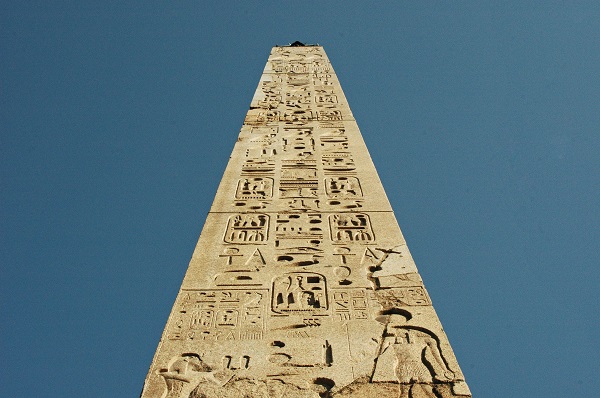
Unveiling the secrets of ancient Egypt requires a journey through time and stone, exploring the monumental structures that echoed with the whispers of a civilization’s mysteries. Stelae and obelisks, standing proudly on the sands of history, reveal more than meets the eye. These towering pillars, adorned with hidden inscriptions, served as both canvas and chronicle for the ancient Egyptians. Join us on an expedition to unravel the enigmatic messages etched in stone, exploring the cryptic tales of religious rites, royal power, and cultural intricacies that lie beneath the surface of these ancient relics. It’s time to decipher the silent language of stelae and obelisks, where each inscription is a brushstroke painting a vivid picture of a civilization lost in time.
Stelae in Ancient Egypt: Commemorative Pillars of Power and Symbolism
In ancient Egypt, a stelae (plural: stelae) refers to a stone slab or pillar, often made of limestone or other types of stone, that is inscribed with text and/or images. Stelae served various purposes and were used for commemorative, religious, and funerary contexts. These inscribed stones played a significant role in conveying information, recording historical events, and expressing religious beliefs. Here are key features and aspects of stelae in ancient Egypt:
Commemoration of Achievements or Events:
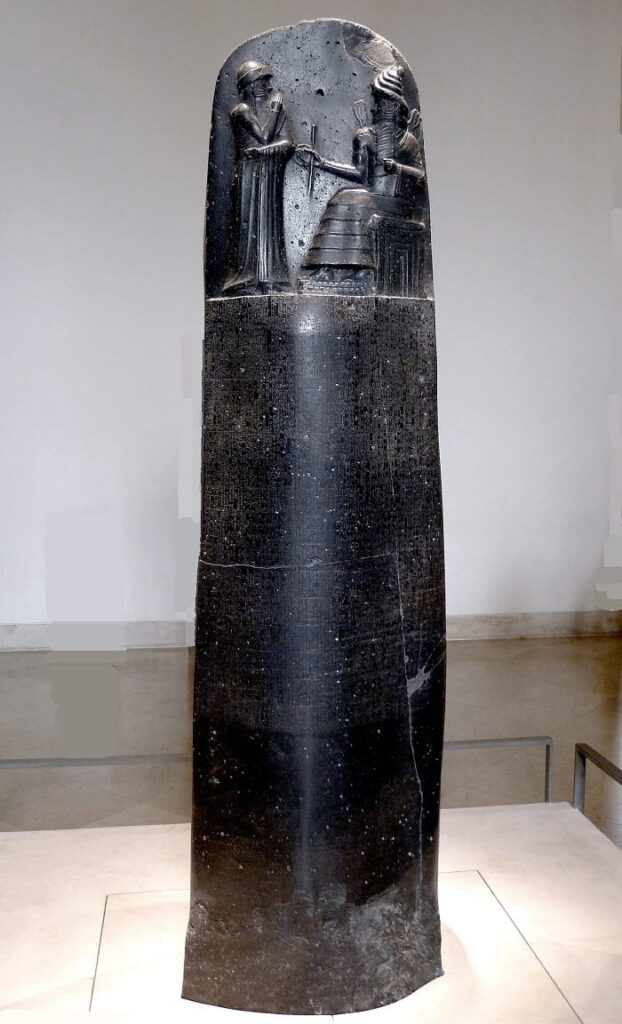
Ancient Egyptians employed stelae to commemorate significant achievements or events. While not an Egyptian example, the Stele of Hammurabi from Mesopotamia is noteworthy. This massive stone slab features the Babylonian king Hammurabi receiving the laws from the god Shamash, symbolizing the establishment of a legal code.
Funerary Practices and Tomb Markers

Stelae played a crucial role in funerary practices, acting as markers for tombs and conveying information about the deceased. An example is the Metternich Stela, a New Kingdom artifact depicting the deceased Metternich making offerings to deities. Such stelae ensured a smooth transition to the afterlife.
Boundary Markers
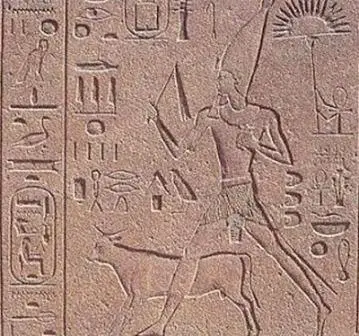
Pharaohs like Amenhotep III utilized stelae as boundary markers during jubilee celebrations like the Heb Sed Festival. The Heb Sed Festival Stela emphasized the divine nature of the king and marked the boundaries of the celebration, reinforcing the king’s rejuvenation and continuity.
Religious Offerings and Devotion
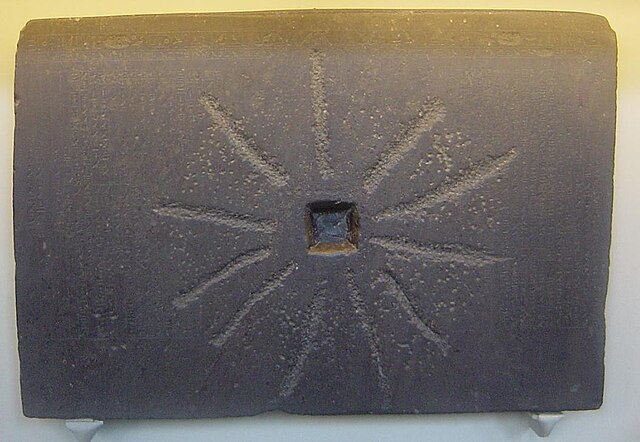
Stelae were erected as expressions of religious devotion. The Shabaka Stone, an inscribed slab, contains the Memphite Theology, a religious text commissioned by Pharaoh Shabaka. It emphasizes the creation of the world and the significance of the god Ptah.
Legal and Administrative Documentation:

The Coptos Decrees, a series of stelae by Seti I and Ramses II, served as legal and administrative documents. These stelae outlined laws regulating trade around Coptos, offering insights into economic practices and administrative functions in ancient Egypt.
Temple Dedication and Construction:
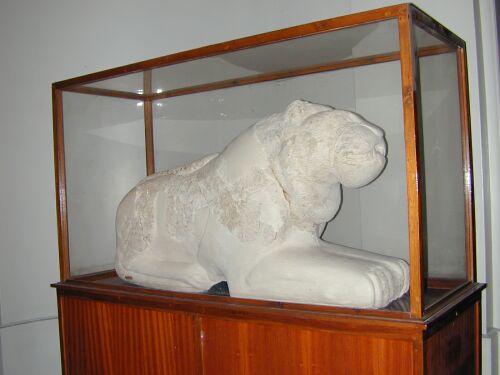
Stelae were commonly used to mark temple dedications and describe construction processes. An example is the Koptos Lions, dedicated to Sekhmet and Bastet. These stelae were placed at the temple entrance, acting as protective guardians and detailing the temple’s construction.
Historical Records and Announcements:

Stelae functioned as historical records and public announcements. The Merneptah Stele, or Israel Stele, commissioned by Pharaoh Merneptah, provides historical insights by mentioning Israel. This victory stele documented the triumphs of the pharaoh and communicated significant geopolitical events.
Communication with the Divine:
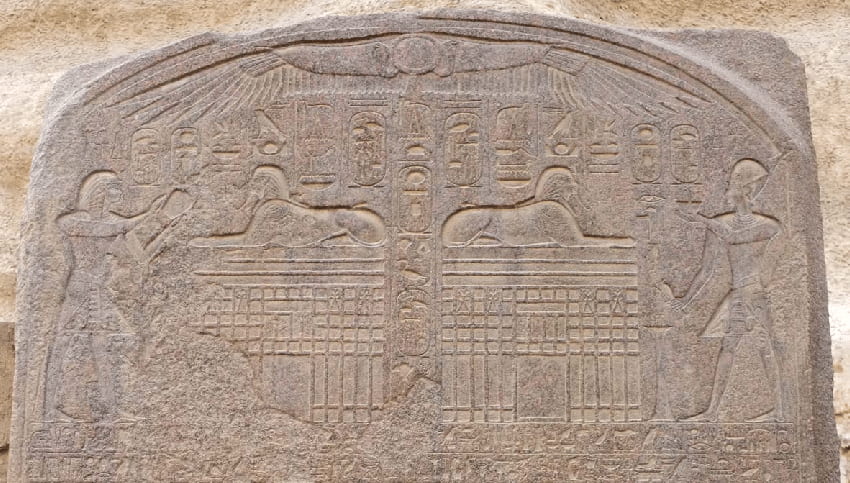
Stelae served as a medium for communication with the divine. Thutmose IV’s Dream Stele recounts the pharaoh’s dream in which the god Horus promised him the throne in exchange for clearing the sand covering the Sphinx. This stele highlighted divine intervention in royal matters.
In summary, stelae in ancient Egypt were versatile monuments, each serving a unique purpose ranging from commemorating individuals and events to expressing religious devotion and communicating with the divine. The inscriptions and reliefs on these stelae provide invaluable insights into the cultural, religious, and historical aspects of ancient Egyptian civilization.
Obelisks of Ancient Egypt: Pillars of Power, Solar Worship, and Architectural Grandeur
Obelisks in ancient Egypt were monumental structures characterized by a tall, narrow, four-sided shape, typically with a pyramidion at the top. They held great religious, cultural, and symbolic significance for the ancient Egyptians. Here are several reasons why ancient Egyptians used obelisks, along with examples:
Religious and Solar Symbolism:
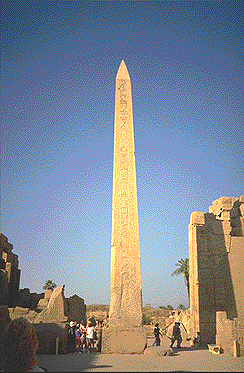
Obelisks were closely associated with the worship of the sun god Ra. The shape of an obelisk, tapering towards the top, symbolized a sunbeam. They were often erected in pairs at the entrance of temples, such as the Karnak Temple in Luxor, to honor Ra and enhance the temple’s connection with solar deities.
Ceremonial and Ritualistic Functions:
Obelisks played a crucial role in religious ceremonies and rituals. The obelisks at the Temple of Karnak, particularly the Obelisk of Hatshepsut, were used during religious processions and festivals. They were essential in conveying the pharaoh’s connection with the divine and the performance of sacred rites.
Markers of Power and Authority:

Pharaohs erected obelisks to assert their power and authority. The most famous pair of obelisks, known as Cleopatra’s Needles, were commissioned by Thutmose III. One stands in London, the other in New York’s Central Park. These obelisks emphasized the reach of Egyptian power beyond its borders and glorified the reigning pharaoh.
Alignment with Cosmic Forces:
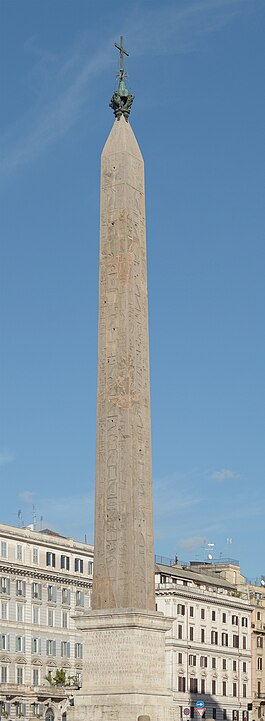
The positioning of obelisks was carefully planned to align with cosmic forces, emphasizing a connection between the earthly and divine realms. The Lateran Obelisk in Rome, originally from Karnak, is an example of an obelisk strategically placed in alignment with the Basilica di San Giovanni, underscoring the cosmic significance.
Symbol of Stability and Endurance:

Obelisks symbolized stability and endurance. The obelisks erected by Ramses II at the Luxor Temple were colossal representations of the king’s enduring rule. These structures, often made from red granite, were built to withstand the test of time, serving as eternal symbols of the pharaoh’s reign.
Architectural Aesthetics and Monumentality:
Obelisks contributed to the architectural grandeur of temples and cities. The Lateran Obelisk in Rome, re-erected by Sixtus V, stands prominently in the Piazza San Giovanni. Its towering presence contributes to the monumental character of the square and the city.
Dedication to Deities:
Obelisks were dedicated to various deities. The obelisks in front of Luxor Temple, including the Obelisk of Ramses II, were offerings to the gods. These monumental structures served as physical manifestations of the pharaoh’s piety and devotion to the divine pantheon.
Astronomical Significance:

Some obelisks had astronomical functions, aligning with celestial events. The obelisk in the Vatican City, originally from Heliopolis, marked the focal point of a sun dial. Its shadow would move along specific lines, indicating various times of the day.
In summary, obelisks in ancient Egypt served a multifaceted role, ranging from religious symbolism and solar associations to expressions of power, architectural aesthetics, and dedication to deities. Each obelisk erected by the ancient Egyptians carried specific cultural, religious, and political significance.
Discovery of Hidden Inscriptions and Messages on Stelae and Obelisks
The discovery of hidden inscriptions and messages on stelae and obelisks has unveiled a captivating dimension of ancient Egyptian culture and history. These monumental structures, prevalent throughout ancient Egypt, were initially erected for various purposes, ranging from commemorating significant events to honoring deities and individuals of importance. However, it is the meticulous examination of these stone monuments that has allowed modern archaeologists and historians to unravel the concealed narratives and cryptic messages engraved on their surfaces.
Stelae, essentially stone slabs or pillars, were utilized by the ancient Egyptians as commemorative markers for a myriad of events such as military victories, royal decrees, and religious ceremonies. The inscriptions on stelae often provided detailed accounts of the accomplishments of pharaohs, the offerings made to gods, and the prevailing sociopolitical climate. As scholars meticulously decipher these inscriptions, a clearer understanding of the historical context and cultural practices of ancient Egypt emerges.
Similarly, obelisks, towering structures characterized by their tall, four-sided design, were adorned with inscriptions that went beyond mere decorative elements. These inscriptions served as a medium for conveying religious beliefs, immortalizing the reign of pharaohs, and inscribing significant celestial and cosmic alignments. The intricate hieroglyphs etched onto the surfaces of obelisks have become crucial in decoding the spiritual and cosmic significance embedded in these colossal monuments.
One notable example is the obelisk of Hatshepsut at Karnak, which not only commemorates the queen’s achievements but also contains hidden references to her unconventional rule. Additionally, the pair of obelisks known as Cleopatra’s Needles, standing in London and New York, reveals inscriptions that boast of the military triumphs of Thutmose III and his dedication to the gods.
The uncovering of these hidden inscriptions has provided a rich tapestry of information, shedding light on the religious fervor, political aspirations, and cultural intricacies of ancient Egypt. As technology and archaeological methods continue to advance, it is likely that more concealed messages on stelae and obelisks will be brought to the forefront, offering new perspectives on the enigmatic world of ancient Egyptian civilization.
Finally, if we want to compare the role of obelisks and stelae in Ancient Egypt, it’s better to read the table below.
| Feature | Obelisks | Stelae |
|---|---|---|
| Form and Structure | Tall, four-sided monuments with a pyramidion at the top. | Varied forms, including slabs of stone or wood, with diverse shapes and sizes. |
| Materials | Usually made of a single piece of hard, durable stone, such as granite. | Made from various materials, including stone and wood. |
| Symbolic Representation | Symbolic of the sun god Ra; represents a connection between earth and the divine. | Diverse functions, including funerary, votive, commemorative, and boundary markers. |
| Alignment | Often erected in pairs at temple entrances, aligned for religious significance. | Placed in various contexts, such as tombstones, votive offerings, and boundary markers. |
| Funerary Usage | Associated with funerary contexts, sometimes part of mortuary temple architecture. | Frequently used as tombstones, sometimes as false doors, allowing movement between realms. |
| Dedications | Dedicatory inscriptions often glorified the pharaoh and expressed devotion to gods. | Diverse inscriptions, including owner names, offering formulas, genealogies, prayers, and events. |
| Purpose | Primarily religious and monumental; often associated with temples and pharaonic glory. | Diverse purposes, including marking tombs, expressing devotion, commemorating events, and delineating boundaries. |
| Commemorative Usage | Could be raised to commemorate significant events or victories. | Frequently erected to commemorate various events or achievements. |
| Location | Typically found at temple entrances or as part of larger architectural compositions. | Found in various locations, including tomb sites, temples, and as boundary markers. |
The Role of Encryption in Ancient Egypt in Monumental Architecture
In the grand tapestry of Ancient Egyptian civilization, monumental architecture served not only as physical structures but as profound expressions of religious, cultural, and political ideologies. Beyond the visible grandeur, the Egyptians employed subtle yet effective forms of encryption within their architectural designs, influencing the way messages were conveyed and understood by a select few. This intricate practice of encoding information added a layer of mystery and exclusivity to the monumental structures, reflecting the divine relationship between the rulers, the people, and their gods.
Hieroglyphs as Architectural Encryption:
Hieroglyphs, the formal inscriptions of logographic, syllabic, and alphabetic elements, played a pivotal role in the encryption of messages within Ancient Egyptian architecture. Carved onto the surfaces of temples, tombs, and pyramids, hieroglyphs served as a unique form of encryption, accessible only to those initiated into the priestly and royal circles. These intricate symbols represented a blend of real and abstract elements, portraying religious narratives, victories, and the lives of pharaohs in a stylized manner. The exclusive nature of hieroglyphic literacy contributed to the encrypted communication within the architectural landscape.
Symbolism and Iconography:
Beyond hieroglyphs, the Egyptians incorporated symbolic elements and iconography into their monumental architecture, adding another layer of meaning that was not readily apparent to the uninitiated. The use of ankh, Djed, Was Sceptre, Scarab, and other symbols held significant cultural and religious connotations, with meanings known to a select few. These symbols were strategically placed, contributing to the encryption of messages related to eternal life, stability, and the divine order of the cosmos.
Temple Layouts and Religious Rituals:
The architectural layouts of temples, such as the Temple of Edfu, were designed to encode religious ideologies and mythological narratives. The pillared halls, transverse halls, and bark sanctuaries contained inscriptions and reliefs that encrypted stories of gods and pharaohs, accessible primarily to priests and the ruling elite. Religious rituals performed within these temples were part of a sacred encryption, with the meaning known only to those initiated into the religious practices of Ancient Egypt.
Influence on Social and Political Dynamics:
The encrypted nature of Ancient Egyptian monumental architecture had far-reaching effects on social and political dynamics. It created a hierarchical structure of knowledge, where priests, rulers, and the educated elite held the key to deciphering the encoded messages. This exclusivity reinforced the authority of the ruling class, as access to the deeper meanings embedded in architecture was a privilege granted to few.
In the realm of Ancient Egyptian monumental architecture, encryption was not confined to the modern digital realm but manifested through hieroglyphs, symbols, and temple layouts. This subtle yet powerful form of encoding added a mystical dimension to the structures, fostering a sense of exclusivity and reinforcing the deep connection between the divine and earthly realms. The encrypted language of Ancient Egyptian architecture remains a testament to the sophistication of their civilization and the strategic use of symbolism to convey messages across time and space.
Cryptography in Ancient Egyptian Society
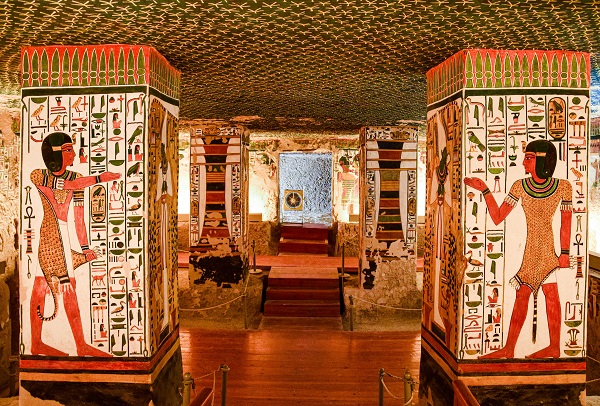
In ancient Egyptian society, cryptography played a role in the form of hieroglyphic writing, particularly in the New Kingdom (from around 1539 to 1075 BCE). Cryptographic hieroglyphic writing involved the use of symbols and signs that were not part of the standard canon of hieroglyphs. These texts appeared unusual and were likely intended to be cryptic, serving as puzzles to entice individuals to decipher them.
The cryptographic inscriptions adhered to the original principles of hieroglyphic script but introduced variations in the forms of signs and their selection. For example, symbols like the mouth were portrayed in profile instead of the front view, deviating from the classical script. The selection of signs could also change, such as using a symbol like a man carrying a basket on his head to represent a phonetic value (in this case, the sound ‘f’), deviating from the standard symbol of the horned viper.
These cryptographic inscriptions suggest the existence of a tradition parallel to the standard methods of hieroglyphic instruction in schools. While mainstream education focused on memorization and recognition, there was another tradition emphasizing analytical understanding of the basic principles of hieroglyphic writing. The cryptographic texts served as challenges for decipherers who possessed a deep understanding of hieroglyphics.
The later development of hieroglyphic writing saw further innovations and a revival of interest, leading to the introduction of new signs and sign groups. However, these developments were distinguishable from cryptographic texts in that they aimed at readability and ease of understanding rather than intentional obfuscation.
The tools used for writing hieroglyphic symbols included chisels and hammers for stone inscriptions and brushes and colors for smoother surfaces like wood. Additionally, a cursive form of hieroglyphic writing, known as hieratic script, emerged for administrative and literary purposes, offering a faster and more convenient method of writing.
In summary, cryptography in ancient Egyptian society manifested in the form of cryptographic hieroglyphic writing, providing a glimpse into the use of codes and puzzles as a means of communication or intellectual challenge in that historical context.
Hieroglyphic Encryption: Concealing Meaning in Symbols
Hieroglyphic encryption in ancient Egypt involved concealing meaning within symbols, creating a form of coded communication using the hieroglyphic script. Hieroglyphs were the pictorial symbols used in the ancient Egyptian writing system. While hieroglyphs were commonly used for everyday communication and monumental inscriptions, some texts exhibited a more cryptic or encoded form of writing.
The encrypted hieroglyphic texts were characterized by the absence of familiar word groups and the presence of signs not found in the standard hieroglyphic canon. These texts, which emerged particularly during the New Kingdom (circa 1539 to 1075 BCE), were likely designed to be enigmatic and served as intellectual challenges for individuals to decipher.
Key features of hieroglyphic encryption included:
- Unfamiliar Symbols: The use of symbols that were not part of the standard hieroglyphic repertoire, introducing elements that were not commonly used in regular communication.
- Varied Sign Forms: Changes in the forms of familiar signs, such as depicting the mouth in profile instead of the front view, even though they retained the same phonetic value.
- Creative Selection of Signs: Introduction of new signs or the utilization of existing signs in novel ways to represent phonetic values or convey specific meanings.
- Intentional Complexity: The cryptographic inscriptions were deliberately complex, requiring a deep understanding of the hieroglyphic script’s basic principles for decipherment.
- Educational Tradition: The existence of hieroglyphic encryption suggested an alternative educational tradition that focused on analytical understanding rather than simple memorization or recognition.
Hieroglyphic encryption was not intended for everyday communication but rather as a form of intellectual engagement. It demonstrated the inventiveness and flexibility of the hieroglyphic writing system, showcasing the ability to adapt and manipulate symbols for various purposes, including the creation of cryptographic puzzles. These encrypted inscriptions provided a glimpse into the intellectual and educational practices of ancient Egyptian society, highlighting the importance of hieroglyphic writing beyond its conventional uses.
Linguistic Appeal of Encryption: Aesthetic Cryptography
The linguistic appeal of encryption in ancient Egypt, specifically in the form of hieroglyphics, can be viewed as a form of aesthetic cryptography. The use of hieroglyphs as a writing system was not only functional but also carried a profound aesthetic quality that enhanced the visual and symbolic aspects of written communication. Here are key points highlighting the linguistic appeal of encryption in ancient Egypt:
Visual Language:
- Hieroglyphic Symbols: Hieroglyphics were a system of writing characterized by intricate and visually striking symbols. Each hieroglyph represented a concept or an object, and the combination of these symbols formed a visual language.
- Aesthetics of Symbols: The symbols themselves had aesthetic appeal, often resembling miniature works of art. The use of animals, plants, and other elements in hieroglyphs contributed to the beauty of the written language.
Artistic Expression:
- Integration with Art: Hieroglyphics were seamlessly integrated with artistic compositions, whether on temple walls, tombs, or other surfaces. This integration elevated the written word to an art form, blurring the lines between language and visual expression.
- Symbolic Imagery: The aesthetic quality of hieroglyphs extended beyond mere representation. The symbols were chosen not only for their phonetic value but also for their symbolic significance, adding layers of meaning to the text.
Ritualistic Inscriptions:
- Sacred and Ritual Contexts: Hieroglyphic inscriptions often had a ritualistic or sacred context, such as inscriptions within temples or tombs. The inclusion of hieroglyphs in these settings elevated the linguistic aspect to a higher plane, emphasizing the sacred nature of the written word.
- Ceremonial Function: The act of inscribing hieroglyphs in these contexts had a ceremonial function, combining linguistic communication with religious and ritualistic practices. The aesthetics of the writing enhanced the overall ceremonial experience.
Encoded Symbolism:
- Symbolic Encoding: Hieroglyphics served as a form of encoding where symbols represented not only sounds but also abstract concepts and ideas. This symbolic encoding added depth to the language, allowing for nuanced communication.
- Coded Messages: In some instances, hieroglyphs were used to convey coded messages, especially in cryptographic inscriptions. The intentional use of certain symbols and the arrangement of hieroglyphs could convey hidden or esoteric meanings.
Educational and Hieratic Scripts:
- Educational Aspect: Learning hieroglyphics was a specialized skill, often reserved for scribes and scholars. The aesthetic appeal of the symbols may have contributed to the allure of learning this intricate writing system.
- Hieratic Script: The cursive form of hieroglyphs, known as hieratic script, was used for everyday purposes. While hieratic lacked the elaborate visual elements of hieroglyphics, it retained a certain aesthetic quality in its flowing and simplified form.
Monumental Inscriptions:
- Monumental Architecture: Inscriptions on monumental structures, such as obelisks and temple walls, featured large-scale hieroglyphics. The grandeur of these inscriptions added to the aesthetic appeal of the architectural landscape.
- Symbolic Power: The monumental use of hieroglyphs conveyed a sense of symbolic power and permanence. The visual impact of these inscriptions contributed to the overall aesthetics of the monumental structures.
Legacy and Contemporary Appeal:
- Enduring Aesthetic Impact: The aesthetic appeal of hieroglyphics has left a lasting impact on art, design, and popular culture. The visual language of hieroglyphs continues to be a source of inspiration in contemporary contexts.
- Artistic Reverence: Artists and designers often draw inspiration from the aesthetic qualities of hieroglyphics, incorporating similar visual elements into modern creations. This reflects a continued reverence for the artistic and linguistic legacy of ancient Egypt.
In summary, the linguistic appeal of encryption in ancient Egypt, particularly in the form of hieroglyphics, was marked by a profound aesthetic quality. The visual language of hieroglyphs transcended mere functionality, blending artistic expression, symbolic encoding, and ritualistic significance. The enduring legacy of hieroglyphics continues to captivate individuals, showcasing the timeless beauty of this ancient form of aesthetic cryptography.
Funerary Encryption: Messages Beyond the Grave in Ancient Egypt
Funerary encryption in ancient Egypt involved the use of symbols, hieroglyphs, and ritualistic inscriptions to convey messages and provide guidance for the deceased in the afterlife. The practice was deeply rooted in the religious beliefs and funerary rituals of ancient Egyptian society. Here are key aspects of funerary encryption in ancient Egypt:
1- Religious Significance:
Ancient Egyptians held strong beliefs in an afterlife, and the funerary rituals were conducted to ensure a successful journey to the realm of the dead. Funerary encryption played a role in these rituals to convey messages relevant to the deceased’s journey.
2- Book of the Dead:
- Funerary Texts: The “Book of the Dead” (known as “The Book of Coming Forth by Day”) was a collection of funerary texts and spells written on papyrus or inscribed on tomb walls. These texts served as guides for the deceased, providing instructions for navigating the afterlife.
- Hieroglyphic Inscriptions: The Book of the Dead often included hieroglyphic inscriptions that were, in a sense, a form of encryption. The use of symbolic language and coded messages aimed to protect the deceased and ensure a successful transition to the afterlife.
3- Symbolic Protection:
- Amulets and Symbols: Funerary practices included the placement of amulets and symbols on the deceased or within the burial chamber. These objects were believed to have protective qualities and could be considered a form of symbolic encryption against malevolent forces in the afterlife.
- Magical Words: Certain words and phrases were considered powerful and magical in ancient Egyptian beliefs. Inscribing these words on tomb walls or including them in funerary texts was a way to invoke their protective properties.
4- Spellcasting for the Deceased:
- Magical Spells: Funerary rituals involved the recitation of magical spells and incantations. These spells were designed to assist the deceased in overcoming challenges and dangers they might encounter in the afterlife.
- Hidden Meanings: Some funerary texts contained hidden meanings and encoded messages, known only to the priests or those initiated into the religious mysteries. These hidden elements added a layer of secrecy and exclusivity to the rituals.
5- Personalized Guidance:
- Individualized Inscriptions: Funerary inscriptions often included personalized elements, such as the name of the deceased and specific details about their life. This personalized information could be considered a form of encryption, providing tailored guidance for the individual in the afterlife.
- Unique Symbols: Certain symbols and hieroglyphs may have held personal significance for the deceased, and their inclusion in funerary contexts could be seen as a way to communicate on a more individualized level.
6- Ensuring Safe Passage:
- Navigating the Underworld: The afterlife was often envisioned as a perilous journey through the underworld, where the deceased faced various challenges. Funerary encryption was employed to ensure safe passage and protection against malevolent entities.
- Judgment Scenes: Depictions of judgment scenes, where the deceased’s heart was weighed against a feather, were common in funerary art. These scenes symbolized the judgment the deceased would undergo and their eligibility for eternal life.
7- Legacy of Funerary Encryption: The legacy of funerary encryption in ancient Egypt is evident in the surviving texts, inscriptions, and artifacts. The practices and beliefs surrounding the afterlife continue to fascinate scholars and enthusiasts, contributing to the enduring cultural legacy of ancient Egypt.
In summary, funerary encryption in ancient Egypt was a multifaceted practice that blended religious beliefs, symbolism, and ritualistic inscriptions to guide the deceased through the afterlife. The use of hieroglyphs, magical spells, and personalized elements contributed to a rich tapestry of encrypted messages aimed at ensuring the safe passage and eternal well-being of the departed.
Cryptography’s Cultural Significance: The Intersection of Art and Secrecy
In ancient Egypt, cryptography held cultural significance by intersecting with art, religion, and the broader societal context. The use of cryptography, particularly in the form of hieroglyphic writing, went beyond functional communication and had deeper implications for the culture of ancient Egypt. Here are some ways in which cryptography intersected with art and secrecy in ancient Egyptian society:
- Hieroglyphic Writing as Artistic Expression: Hieroglyphic writing was inherently artistic, using symbolic pictorial representations of objects, animals, and concepts. The aesthetic quality of hieroglyphs turned writing into a form of visual art, showcasing the creativity and craftsmanship of ancient Egyptian scribes.
- Secrecy and Mystique in Cryptographic Hieroglyphs: Cryptographic hieroglyphs, characterized by the use of unusual symbols and encoded writing, added an element of secrecy and mystique. These encrypted inscriptions were not just functional but served as intellectual challenges, enticing individuals to decipher the hidden messages.
- Educational Traditions: The existence of cryptographic hieroglyphs hinted at parallel educational traditions in ancient Egypt. While mainstream education focused on memorization and recognition of standard hieroglyphs, the cryptographic inscriptions suggested another tradition that transmitted knowledge of hieroglyphic principles through analytical understanding.
- Evolution of Writing Systems: The evolution of hieroglyphic writing showcased an artistic adaptation of the script over time. The introduction of new signs and the development of cryptographic texts demonstrated the flexibility of the writing system, incorporating artistic elements in response to cultural shifts.
- Religious and Ritualistic Cryptography: Cryptography often intersected with religious practices. Hieroglyphs were used in religious texts and rituals, and the encoded messages in these contexts held spiritual significance. The combination of art and secrecy in religious inscriptions reflected a deep connection between language and spirituality.
- Symbolism and Cultural Identity: Hieroglyphs served as cultural symbols that conveyed meanings specific to ancient Egyptian society. The use of symbols, whether in standard hieroglyphs or encrypted forms, contributed to the preservation and expression of cultural identity.
- Monumental Inscriptions: Cryptographic elements were not limited to smaller inscriptions but extended to monumental works, such as obelisks and temple walls. The integration of artistry into these large-scale cryptographic inscriptions showcased the cultural and societal importance attached to secrecy in communication.
- Legacy of Hieroglyphic Art: The legacy of hieroglyphic art endured beyond the ancient Egyptian civilization. The artistic and cryptographic elements of hieroglyphs continue to captivate modern audiences, contributing to the cultural significance of ancient Egypt in contemporary times.
In summary, cryptography’s cultural significance in ancient Egypt was deeply intertwined with art, religion, and educational traditions. The intersection of art and secrecy in hieroglyphic writing not only served practical communication needs but also reflected the creative and symbolic expressions of the culture, leaving a lasting legacy that continues to be appreciated and studied today.
Application of Encryption in Religious Rituals and Ceremonies
In the mystical tapestry of Ancient Egypt’s rich cultural heritage, the application of encryption transcended the realms of everyday communication and ventured into the sacred precincts of religious rituals and ceremonies. Beyond mere linguistic embellishments, cryptography played a pivotal role in infusing an aura of sanctity into these ancient practices.
Hieroglyphs as Sacred Symbols:
Hieroglyphs, the sacred symbols of Ancient Egypt, were not merely a form of written communication but served as conduits between the earthly and divine realms. In religious rituals, the careful selection and arrangement of hieroglyphs were akin to crafting a sacred code—a language understood not only by priests and scribes but also by the gods themselves.
Encoded Blessings:
Within the sacred texts, such as the chapters of the Book of the Dead, encrypted blessings and invocations were woven into the fabric of religious ceremonies. These encoded messages, hidden in plain sight, carried the supplications of the living to the ears of the divine. The act of encryption became a ritualistic endeavor, a sacred artistry that elevated the spoken word to a transcendent plane.
Secrecy as Reverence:
The use of encryption in religious contexts was not an attempt to hoard knowledge but a gesture of reverence. The encrypted passages were meant to be deciphered by those initiated into the sacred mysteries. The intentional obscurity of certain rituals, veiled in cryptographic symbolism, created an atmosphere of awe and respect, emphasizing the sanctity of the divine connection.
Cryptic Inscriptions on Funerary Objects:
Religious ceremonies extended into the realm of the afterlife, where funerary objects became canvases for encrypted expressions. Sarcophagi, statues, and tomb inscriptions bore encrypted messages that transcended the boundaries of mortal existence. These inscriptions served as guides, ensuring safe passage through the intricate journey of the afterlife.
Decoding the Divine Will:
In the practice of divination and oracular rituals, cryptography played a role in decoding the divine will. Priests, equipped with the knowledge of sacred symbols and their hidden meanings, interpreted encrypted messages from the gods. The act of decryption became a sacred duty, bridging the earthly and divine realms in service of the community.
Legacy in Modern Spiritual Practices:
The cryptographic threads woven into ancient religious rituals have left an indelible mark on the evolution of spirituality. The modern concept of sacred symbols, mantras, and encrypted prayers echoes the practices of Ancient Egypt. The reverence for secrecy and the belief in the transformative power of encrypted words continue to shape spiritual practices across cultures.
In exploring the application of encryption in religious rituals and ceremonies in Ancient Egypt, we unravel a tapestry of sacred artistry. Cryptography, far from being a mundane tool for communication, became a conduit for the sacred. The encrypted blessings, rituals, and oracular messages spoke of a profound connection between the earthly and the divine—a connection that transcends time, leaving an enduring legacy in the spiritual practices of civilizations yet to come.
Encryption in Administrative and Governmental Communication
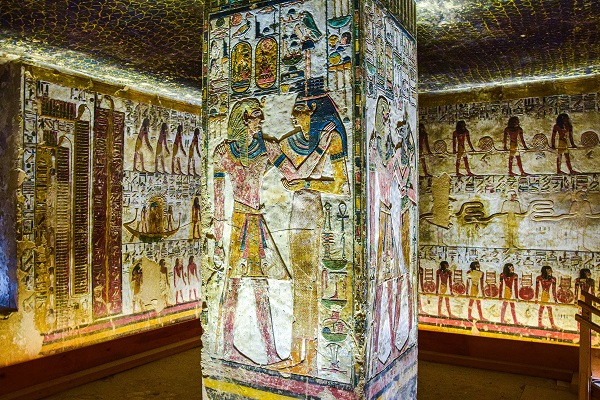
Cryptography, the art of hidden writing, has a rich history that extends back to ancient civilizations. In the case of Ancient Egypt, cryptography played a fascinating role in various aspects of society, including religious rituals, ceremonies, and, notably, administrative and governmental communication. The use of encryption in administrative affairs highlights the sophisticated methods employed by the ancient Egyptians to secure sensitive information and maintain the integrity of their governance.
Administrative Cryptography in Ancient Egypt:
Ancient Egyptian society, known for its advanced administrative systems, relied on secure communication channels to transmit sensitive information related to governance, trade, and other administrative matters. Encryption, with its roots in the complex hieroglyphics of the time, became an integral part of safeguarding the confidentiality and authenticity of administrative messages.
Hieroglyphic Encryption:
The altered forms of hieroglyphics began to appear as early as the third millennium BCE, gaining prevalence during the New Kingdom period (1539–1075 BCE). Scribes strategically added or subtracted symbols, creating encrypted versions of hieroglyphics to conceal the true meaning of inscriptions. This cryptographic practice extended to religious texts, such as chapters of the Book of the Dead, and administrative documents, underscoring its versatile application in ancient Egyptian society.
Purpose and Functionality:
The encryption of administrative and governmental communications served a dual purpose. Firstly, it aimed to protect sensitive information from unintended disclosure, ensuring that only authorized individuals could decipher the encoded messages. This aspect of cryptography was crucial in maintaining the confidentiality of state affairs, strategic decisions, and other classified data.
Secondly, encryption in administrative communication also functioned as a means of verification. By employing cryptographic techniques, the sender and recipient could authenticate the origin of the message. This played a pivotal role in preventing forgeries and unauthorized tampering with official correspondence, thereby establishing a secure and trustworthy communication network within the administrative framework.
Hieroglyphic Complexity and Linguistic Appeal:
Similar to cryptography’s use in religious inscriptions, the hieroglyphic encryption in administrative communication was not merely functional but also carried a linguistic appeal. The complexity of the encrypted symbols and characters was designed to catch the attention of those who passed by, intriguing them to decipher the message. This linguistic allure added an element of mystery to the administrative communications, making them more engaging for potential readers.
In the annals of cryptography, the application of encryption in administrative and governmental communication in ancient Egypt stands as a testament to the sophistication of this ancient civilization. The deliberate use of hieroglyphic encryption served not only to protect sensitive information but also to maintain the integrity and authenticity of administrative affairs. The lessons learned from ancient Egyptian cryptographic practices continue to resonate in the modern world, underscoring the timeless importance of secure communication in the fabric of governance.
Ancient Egypt Army
Ancient Egyptian military strategies often involved a combination of infantry, chariots, and naval forces. They were known for their well-organized and disciplined approach to warfare. The military employed various tactics depending on the situation, such as combining the strengths of infantry, chariots, and navy to maximize combat effectiveness. Additionally, the Egyptian army was adept at siege warfare, using battering rams, siege towers, and other specialized equipment to weaken enemy defenses before launching a final assault.
As for the use of coded messages, there is limited direct evidence from ancient Egypt. However, it’s known that ancient civilizations, including Egypt, used various forms of communication to convey military orders securely. Coded messages, including hieroglyphs and other symbolic writings, might have been employed to protect sensitive information and strategic plans.
Next, we will have a quick look at how the Egyptian army evolved in ancient times:
- Early Formation of the Egyptian Army:
This part outlines the evolution of the Egyptian military from disorganized tribal groups into a sophisticated force. Narmer, the first pharaoh of the Old Kingdom, laid the groundwork for the army. Initially, infantry units armed with simple weapons and shields formed the backbone, playing a crucial role in protecting borders. The first intermediate period brought changes with regional rulers raising private armies, incorporating professional soldiers and new military technologies. - The Middle Kingdom and The New Kingdom:
With the reunification of Egypt under the Middle Kingdom, the need for a cohesive military force became critical. The army underwent reorganization and revitalization, expanding its influence throughout the region. The Middle Kingdom introduced innovations such as composite bows and horse-drawn chariots, revolutionizing warfare. The New Kingdom marked the pinnacle of the Egyptian Army’s power, embarking on ambitious military campaigns with advanced weaponry. - Composition and Organization of the Egyptian Army:
The New Kingdom’s Egyptian Army was a diverse force comprising infantry, archers, slingers, spearmen, and chariots. The navy played a crucial role in controlling the Nile and Mediterranean, supporting military campaigns and safeguarding trade routes. Support personnel ensured the army’s sustenance, constructing fortifications and maintaining supply lines. The ability to sustain forces over long distances was crucial for the Egyptian Army’s success. - Military Tactics and Strategies:
The ancient Egyptian Army employed a variety of tactics, emphasizing combined arms and coordination. Infantry, chariots, and navy worked together, exploiting enemy weaknesses. Precise coordination and communication were essential for maximizing combat effectiveness. Siege warfare tactics included battering rams and specialized equipment to weaken enemy defenses before a final assault. Egyptian commanders strategically used terrain advantages, such as high ground, rivers, and cliffs. - Training and Discipline:
The effectiveness of the Egyptian Army relied on rigorous training and discipline. Soldiers underwent training in weapons handling, hand-to-hand combat, archery, and tactics. Drills and exercises maintained physical fitness and battlefield readiness. Performance was closely monitored, with rewards for excellence, fostering discipline, unity, and loyalty among the troops. - The Role of the Pharaoh in Warfare:
The Pharaoh played a critical role as the political and religious leader, responsible for the overall strategy and direction of the Egyptian Army. Some pharaohs, like Thutmose III and Ramses II, personally led their forces in battle, enhancing their authority. Military campaigns were used to reinforce the pharaoh’s power and project dominance over the empire. - The Decline of the Egyptian Army:
Despite its impressive history, the Egyptian Army faced a decline during the late period due to internal strife, political instability, and an inability to keep pace with technological innovations of rivals. Civil wars weakened central authority, leading to a fragmented and ill-equipped military force. The decline marked a contrast to the army’s earlier formidable reputation.
Challenges in Deciphering Ancient Egyptian Encryption
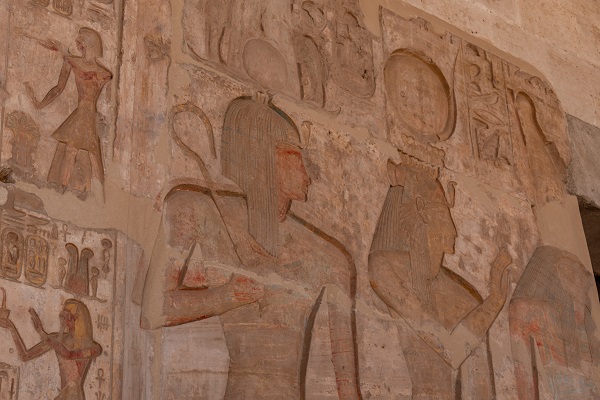
Have you ever wondered about the mysterious symbols etched onto the walls of ancient Egyptian tombs and monuments? The intricate hieroglyphs, with their fascinating blend of art and language, have puzzled scholars for centuries. In the early 19th century, two extraordinary individuals, Thomas Young and Jean-Francois Champollion, embarked on a daring journey to decipher the secrets hidden within these cryptic characters.
Imagine a time when the ancient script of hieroglyphs was an enigma, with no Rosetta Stone to guide scholars in their quest for understanding. Young, a polymath of his era, and Champollion, a tenacious linguist, found themselves at the forefront of a challenge that would reshape our understanding of ancient Egypt.
The Setting: Egyptian Hall and the Rosetta Stone
Picture the scene in the Egyptian Hall in Piccadilly, a peculiar venue inspired by Egyptomania, constructed in 1812 and sadly demolished in 1905. In this hall, an exhibition unfolded in May 1821, captivating 2,000 visitors who eagerly paid half a crown to witness wonders from the Valley of the Kings. Alessandro Ricci’s paintings adorned the walls, showcasing the vulture goddess Nekhbet and mysterious cartouches – symbols that remained unreadable in 1821.
The star of the exhibition was a three-meter-long alabaster sarcophagus, a relic from ancient Egypt, adorned with hieroglyphs in a mesmerizing shade known as Egyptian blue. This artifact, initially overlooked by the British Museum, found a new home in the atmospheric basement of Sir John Soane’s museum in London.
The Pioneers: Young and Champollion
Enter Giovanni Belzoni, the flamboyant circus strongman turned Egyptologist, who discovered the tomb in 1817. The tomb, assumed to be that of Pharaoh Psammis, posed a mystery due to the unreadable hieroglyphs. Thomas Young, a man of boundless talents, speculated about Psammis but hesitated, unsure of the script’s phonetic elements.
Champollion, in 1822, startled the world with the revelation that he could decipher cartouches of late Egyptian rulers. However, the challenge lay in the earlier rulers, like Psammis, whose names remained elusive. A pivotal moment arrived when Champollion started making progress, revealing that the tomb belonged to Setos or Seti the first, circa 1279 BC.
The Rosetta Stone: A Key to Decipherment
The linchpin in this decipherment saga was the Rosetta Stone, discovered by the French army in 1799 and now residing in the British Museum. Young, in his meticulous study, compared the hieroglyphs to the Greek translation on the stone’s last line. The stone’s Greek inscription declared that the three scripts—hieroglyphic, Demotic, and Greek—conveyed equivalent meanings, providing a critical clue.
Challenges Unveiled
Deciphering ancient Egyptian encryption presented formidable challenges:
- Script Complexity: Hieroglyphs were intricate, symbolic, and laden with meaning, posing a formidable barrier to understanding.
- Mixed Scripts: Young’s speculation about Demotic being a mix of hieroglyphs and alphabetic letters added layers of complexity.
- Phonetic vs. Symbolic Debate: Scholars grappled with determining whether hieroglyphs held purely symbolic or phonetic elements.
- Political Turmoil: Champollion faced political adversity, while Young found himself caught in the crossfire of political changes.
- Limited Access to Artifacts: Scholars had to work with copies and illustrations, lacking direct access to the original artifacts.
Triumph Amidst Turmoil
Despite these challenges, Young and Champollion persisted, navigating through political upheavals and scholarly debates. The breakthrough came with Champollion’s revelation of Seti the first as the tomb’s occupant, demonstrating the triumph of perseverance and intellectual acumen.
The decipherment of ancient Egyptian hieroglyphs stands as a testament to human curiosity and the relentless pursuit of knowledge. Young and Champollion’s legacy endures, reminding us that even the most cryptic codes can be unraveled with dedication, insight, and a touch of brilliance.
The Legacy of Ancient Egyptian Encryption
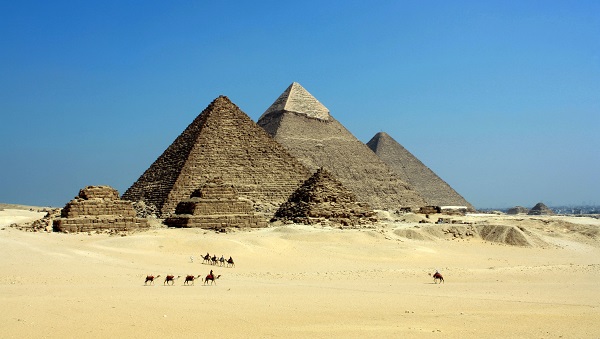
Ancient Egypt, a cradle of civilization along the banks of the Nile, left behind a profound legacy that extends beyond pyramids and pharaohs. One often-overlooked aspect is the sophisticated system of encryption developed by the ancient Egyptians, which has left an indelible mark on the realms of cryptography and communication. Examining the legacy of ancient Egyptian encryption reveals its profound influence on later civilizations, sheds light on contemporary understanding, and unveils ongoing research in deciphering encrypted messages.
A. Influence on Later Civilizations and Cryptography
The impact of ancient Egyptian encryption reverberates through the annals of history, leaving an enduring imprint on later civilizations. The innovative practices of concealing messages, as evidenced by the disordered hieroglyphics used by Egyptian monks around 1900 BCE, served as a precursor to more advanced cryptographic systems. The Greek scytale, introduced circa 500 BCE, demonstrated the evolution toward true cryptology with the introduction of a key, setting the stage for the development of more sophisticated methods.
The encryption methods employed by ancient Egyptians influenced subsequent civilizations, such as the Romans. Julius Caesar’s use of the Caesar Cipher, a substitution cipher involving letter shifts, drew inspiration from earlier Egyptian practices. The utilization of geometric substitution ciphers by groups like the Freemasons showcased a continued reliance on ancient Egyptian principles, although these methods were often susceptible to decryption.
The Rosetta Stone, dating back to 196 BCE, marked a pivotal point in cryptographic history. While not a cryptographic system per se, it provided a translation key for understanding Ancient Egyptian hieroglyphs, offering a glimpse into the concept of cryptographic translation aids. This multifaceted influence laid the groundwork for the multifarious cryptographic techniques that emerged in subsequent eras.
B. Contemporary Understanding of Ancient Egyptian Encryption Methods
In contemporary times, the study of ancient Egyptian encryption methods provides valuable insights into the evolution of cryptographic practices. The decipherment of hieroglyphs, once an inscrutable mystery, unfolded with the groundbreaking discovery of the Rosetta Stone in 1799 by Napoleon’s forces. This pivotal find, inscribed with the same message in three scripts – hieroglyphs, demotic scripts, and Ancient Greek – facilitated the understanding of ancient Egyptian languages and symbolism.
The study of ancient Egyptian encryption has been buoyed by technological advancements, allowing scholars to employ computational tools and linguistic analysis to decode encrypted messages. The understanding of hieroglyphs, once reliant on educated guesses, has evolved into a nuanced comprehension of the linguistic and symbolic intricacies embedded in the Egyptian script.
C. Ongoing Research and Discoveries in Deciphering Encrypted Messages
Ongoing research endeavors focus on unraveling the mysteries of encrypted messages from ancient Egypt. With advancements in computational linguistics, artificial intelligence, and collaborative scholarly efforts, researchers are delving into previously indecipherable texts, seeking patterns and linguistic nuances that eluded earlier generations.
The quest for understanding ancient Egyptian encryption methods extends beyond linguistic decipherment to explore the cultural, religious, and societal contexts that influenced the creation of encrypted messages. Ongoing archaeological discoveries and interdisciplinary approaches provide a more holistic understanding of encryption as an integral part of ancient Egyptian communication.
Legacy and Transition: Hieroglyphics to Digital Codes
The transition from ancient Egyptian hieroglyphics to modern digital codes represents a remarkable evolution in the use of symbols and written communication. While the cultural legacy of ancient Egypt endures, the methods of encoding and decoding information have undergone profound changes over the millennia. Here are some key aspects of the legacy of ancient Egypt and the transition from hieroglyphics to digital codes:
Symbolic Representation:
- Hieroglyphics: Ancient Egyptian hieroglyphics were a system of symbolic representation, where each symbol or glyph conveyed a specific meaning or concept. The visual nature of hieroglyphs allowed for a rich and expressive form of written communication.
- Digital Codes: Similarly, modern digital codes rely on symbolic representation, where sequences of binary digits (bits) represent information. The use of 0s and 1s in digital coding serves as a fundamental symbolic language for conveying data in the digital era.
Cultural Symbolism:
- Hieroglyphic Legacy: The cultural symbolism embedded in hieroglyphics continues to resonate in modern times. Hieroglyphs are iconic symbols associated with ancient Egypt, and their aesthetic appeal has influenced art, design, and popular culture.
- Digital Symbols: In the digital age, symbols take the form of alphanumeric characters, icons, and specialized symbols used in coding languages. The symbolism of these digital symbols carries cultural significance within the context of technology and communication.
Evolution of Writing Systems:
- Hieroglyphic Evolution: Hieroglyphic writing evolved over millennia, adapting to societal changes and cultural shifts. The system incorporated both standard and cryptographic forms, showcasing its flexibility.
- Digital Evolution: The evolution of writing systems in the digital era is marked by the transition from analog to digital technologies. Digital codes have evolved with the development of computer systems, programming languages, and communication protocols.
Communication Technologies:
- Hieroglyphic Inscriptions: Hieroglyphic inscriptions were found on various surfaces, including stone, papyrus, and wood. These inscriptions served as a means of communication in diverse contexts, from monumental structures to everyday writings.
- Digital Communication: Digital codes facilitate communication in the virtual realm. From email and messaging platforms to internet protocols, digital codes enable the transmission of information across vast distances, reshaping the way societies connect.
Accessibility and Ubiquity:
- Hieroglyphic Accessibility: Hieroglyphics were accessible to a select group of scribes and scholars who underwent specialized training. The complexity of hieroglyphic writing contributed to its exclusivity.
- Digital Ubiquity: Digital codes, on the other hand, are ubiquitous in modern society. The accessibility of digital technologies has democratized information access and communication, making digital codes a fundamental part of daily life for a global population.
Educational Significance:
- Hieroglyphic Education: Education in hieroglyphics was a specialized discipline in ancient Egypt, with scribes learning the intricate system of writing. The transmission of knowledge relied on oral traditions and written texts.
- Digital Literacy: In the digital age, digital literacy has become a fundamental skill. Understanding and using digital codes, programming languages, and digital tools are essential components of contemporary education.
Preservation of Cultural Heritage:
- Hieroglyphic Preservation: The decipherment of hieroglyphics in the modern era, most notably through the Rosetta Stone, has enabled the preservation and interpretation of ancient Egyptian texts. This has contributed to our understanding of the civilization.
- Digital Archives: The preservation of cultural heritage in the digital age involves the creation of digital archives, where texts, images, and multimedia content are stored electronically for future generations.
Global Impact:
- Hieroglyphic Influence: The influence of ancient Egyptian culture, including hieroglyphics, has had a lasting impact on global art, architecture, and literature. The fascination with Egyptology persists worldwide.
- Digital Globalization: Digital codes are a driving force behind globalization. The interconnectedness of digital networks facilitates global communication, trade, and collaboration, transcending geographical boundaries.
In conclusion, the legacy of ancient Egyptian encryption is a rich tapestry interwoven with the threads of linguistic ingenuity, cultural symbolism, and cryptographic evolution. Its influence on later civilizations reverberates through history, while contemporary research continues to unveil the secrets encoded in the messages of the distant past. The study of ancient Egyptian encryption not only sheds light on an intriguing chapter of human communication but also serves as a testament to the enduring fascination with unlocking the mysteries of our ancestors.

best vpn in the world – Encryption in Ancient Egypt
Conclusion
The encryption practices of ancient Egypt stand as a testament to the timeless human pursuit of securing and concealing information. From the disordered hieroglyphics of Egyptian monks to the more structured systems like the scytale and the Caesar Cipher, the ancient Egyptians demonstrated a profound understanding of the need for privacy in communication. Encryption was not merely a tool for them; it was a sophisticated art woven into the fabric of their culture.
The importance of encryption in ancient Egypt lay not only in the practicalities of safeguarding messages but also in its cultural and societal implications. The encrypted messages carried the weight of religious rites, sacred knowledge, and the affairs of state. The ability to encrypt and decrypt messages was a skill held by a select few, emphasizing the exclusivity and significance of such knowledge in ancient Egyptian society.
Despite centuries of scholarly inquiry, the mysteries of ancient Egyptian encryption persist, shrouding certain messages in an enigmatic veil. The intricacies of their cryptographic techniques, the specific keys used, and the full extent of the cultural nuances embedded in encrypted messages remain elusive. The decipherment of ancient Egyptian hieroglyphs was a groundbreaking achievement, but it also unveiled the vastness of the unknown that still exists within the encrypted texts.
Acknowledging the mysteries that endure invites a sense of humility in the face of the ancient Egyptians’ intellectual prowess. As technology and methodologies continue to advance, the pursuit of decrypting these lingering mysteries becomes an ongoing dialogue between the past and the present. The gaps in our understanding spark curiosity and fuel the determination to unlock the encrypted wisdom of this ancient civilization fully.
The legacy of ancient Egyptian encryption is not confined to the annals of history; it resonates in the very foundations of modern cryptography and communication. The rudimentary methods of encryption devised by Egyptian monks and the more sophisticated systems that followed have left an indelible mark on the cryptographic landscape. Elements such as translation aids, substitution ciphers, and the concept of key-based encryption pioneered by the Egyptians continue to shape contemporary cryptographic practices.
In the modern world, where data security is paramount, the lessons from ancient Egyptian encryption are particularly relevant. The need for comprehensive data protection, the importance of key management, and the role of a trusted authority in verifying identities all find echoes in the cryptographic principles first glimpsed along the Nile. The enduring legacy of ancient Egyptian encryption is not just a historical curiosity but a living influence that permeates our digital age.
As we navigate the complexities of modern encryption, we do so with a nod to the ancient Egyptians who, millennia ago, grappled with similar challenges and laid the groundwork for the intricate science of securing information. Their legacy lives on, reminding us that the pursuit of encryption is not merely a technical endeavor but a cultural and intellectual journey with roots that stretch far back into the sands of time.
